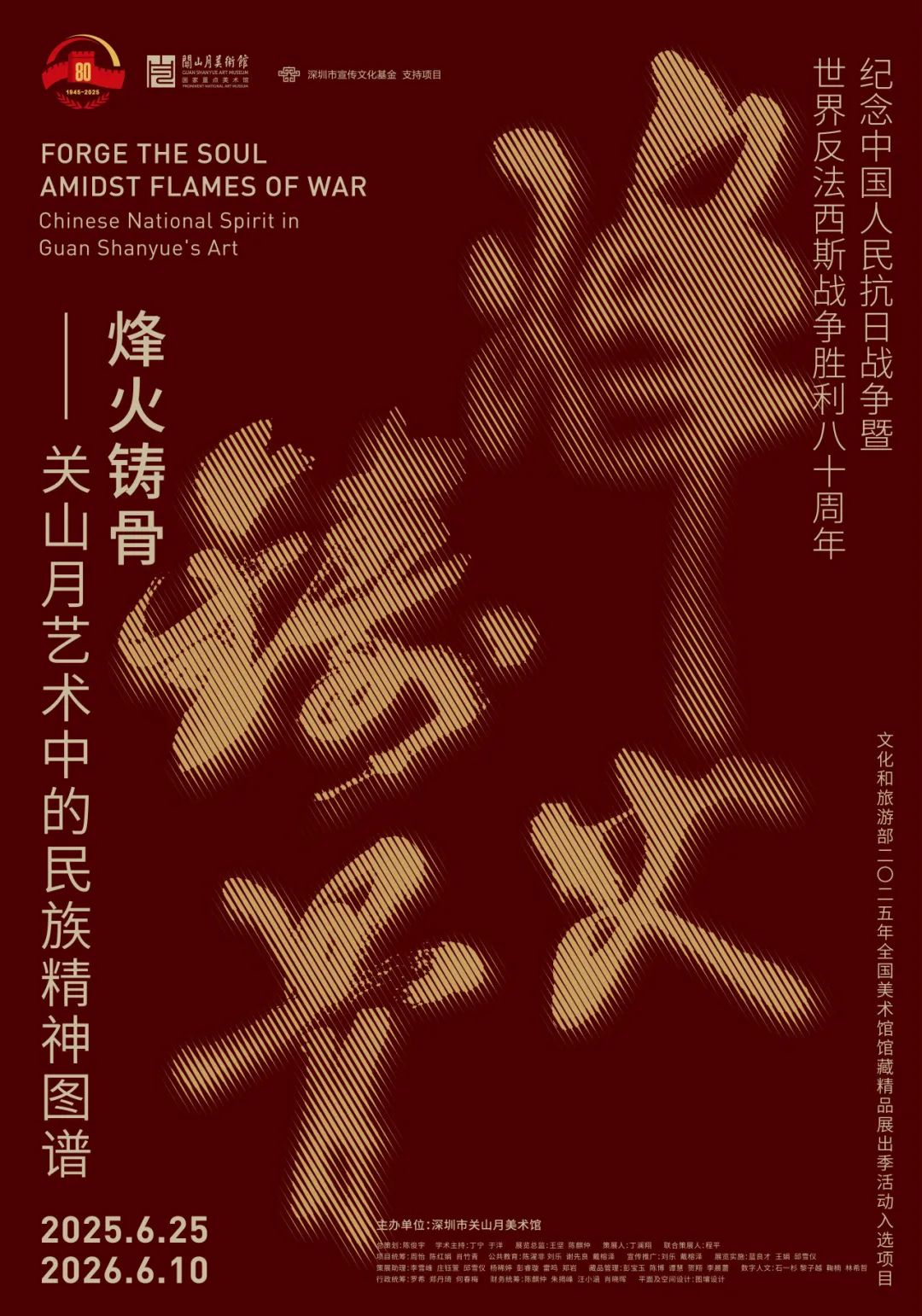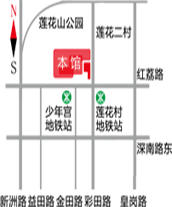
- New Exhibition | Flames Casting Bones - National Spirit Atlas in Guan Shanyue's Art
-

Click to view foreword
On the occasion of the 80th anniversary of the victory of the Chinese People's War of Resistance against Japanese Aggression and the World Anti Fascist War, Shenzhen Guanshanyue Art Museum carefully planned and launched the special exhibition "Beacon fire casts bone - the national spirit atlas in Guanshanyue's art". The exhibition provides an in-depth analysis and presentation of over 30 exquisite works of Guan Shanyue art from the museum collection, depicting a magnificent picture from the national salvation cry to the rejuvenation chapter in times of peace from a unique perspective.
In the late 1930s, facing the national crisis, the young Guan Shanyue resolutely stepped into the world of beacon art. In the tide of the Anti Japanese War, he consciously shouldered the national security and devoted himself to the literary and artistic cause of saving the nation with passionate strokes, embarking on a creative journey of expressing the ideal of national rejuvenation through anti Japanese war paintings and travel sketches. Looking back at these 'art stained with gunpowder', they are not only silent accusations of aggression and atrocities, but also visual melting of the national soul. We hope that viewers will remember the eternal warning of history, and turn the suffering witnessed by art into a spiritual wall that safeguards peace.
This exhibition presents the paintings of Guan Shanyue during the Anti Japanese War and the national spirit symbols of the New China period in a juxtaposed manner, clearly outlining the spiritual lineage of the artist's half century creative career from salvation to national rejuvenation, and demonstrating the true meaning that art is always connected to the bloodline of the people. These works collectively confirm the artistic motto of "pen and ink should follow the times", vividly depicting the heroic struggle of "using pen as a gun" in times of national crisis and the eternal praise of "the land is beautiful" in times of peace. Adhering to the spirit of the times, Guan Shanyue strives to construct a magnificent atmosphere of national self-reliance and prosperity with her exquisite brushwork. This not only reveals the historical necessity of "from humiliation to rise" under the leadership of the CPC, but also builds the cornerstone of the belief of "not forgetting national humiliation and revitalizing China" with a magnificent visual epic through the interaction of artistic truth and historical truth.
Director of Guanshanyue Art Museum in Shenzhen
Chen Junyu
one
Retreat from the city
The "retreat from the city" is not only Guan Shanyue's personal experience of fleeing after the fall of Guangzhou, but also the tragic exile of Guangzhou citizens he witnessed, and it is a microcosm of the suffering of urban residents in China's occupied areas during wartime. This retreat dragged Guan Shanyue into the tide of the Anti Japanese War era, opening up his magnificent journey to travel half of China after leaving Guangzhou. His walking sketches reconstruct the spatial interaction between art and the times through the extension of geographical space.
two
Suffering and rebirth
Guan Shanyue depicted with compassionate ink the refugees, widows, and women and children who were ravaged by aggressors during the war. This is not only the collective suffering of the nation, but also the war scars branded on the lives of every countrymen. The people who bend down to work and the scholars who stand firm in the flames of war in his writings are like pillars in the torrent of suffering, silently carrying the indomitable spirit of the nation. With the victory of the War of Resistance against Japan and the War of Liberation, the Chinese people not only defeated Japanese imperialism, but also achieved a complete political turnaround. After being tempered by war, Guan Shanyue devoted all her enthusiasm to the cause of "art for the people" and continued to write a new chapter of national spirit with her paintbrush.
three
Smoke and Tides
In 1939, amid the gunsmoke of the the Pearl River Estuary, the young Guan Shanyue fixed the moment of Japanese bombardment of fishing boats with "The Fisherman's Disaster" and "What I See Outside Sanzao Island", which became a visual testimony to accuse aggression and atrocities and witness national suffering. More than forty years later, in "Returning to the Sail", the fishing port with numerous masts and a full load of returning sails was reshaped by Guan Shanyue with warm words, creating a peaceful and prosperous scene along the coastline. This intense contrast across time and space is a microcosm of the historical turbulence in 20th century China. In this chapter, the imagery of "smoke and tide" is juxtaposed to explore the brushstrokes of Guan Shanyue as she travels through the folds of history - a solemn cry for national salvation during wartime, and a heartfelt tribute to the lives of the people in peacetime.
four
Landscape and Homeland
Guan Shanyue once said, "There can be no front without a rear, no resistance without mountains and waters." His landscape painting creations during the Anti Japanese War period were an artistic innovation that infused national salvation consciousness into traditional painting. This creative shift is not about escaping reality, but about carrying the spirit of resistance in a more flexible way. He chose to use brush and ink to reconstruct the integrity of mountains and rivers, breaking through the reclusive taste of traditional literati painting through on-site sketching, and reconstructing the visual boundaries of the nation-state. There is a profound continuity and transformation relationship between Guan Shanyue's landscape painting during the New China period and his sketching during the Western Expedition during the Anti Japanese War. During the War of Resistance Against Japan, sketching in the southwest, northwest, and southwest not only accumulated techniques and thematic materials for the creation of new Chinese landscape themes, but also shaped a method that integrates national narrative and realistic observation.
five
Iron Bones and Rivers
Amidst the smoke of gunpowder, Guan Shanyue was forced to draw flowers such as roses and red cotton in exchange for a livelihood. The painting poem "Spring cold roses sprout new buds, recalling the cold falling flowers of the past. I am only ashamed to live against my heart, not because of worldly wisdom and sentimentality" expresses the artist's inner struggle and helplessness. Forty years later, Guan Shanyue reconstructed the symbolic meaning of red cotton with "Red Cotton and White Dove": the strong branches are like iron bones soaring in the sky, the burning vermilion flowers are like hot blood rushing, and the white dove lives in it, announcing the peace of the smoke of gunpowder dissipating. This painting transcends the depiction of regional landscapes and becomes a portrayal of national spirit: the thick and robust branches of red cotton evoke the unyielding backbone of the nation forged from the humiliation and tears of war.
The songs' Wild Geese in the Southern and Northern Boundaries' and 'Wind and Rain for Thousands of Years, Tai Yue Song' are the continuation and expansion of the 'Jiangshan' paradigm. They condense the grandeur of the national space and the grandeur of historical time, transcending specific topographical depictions and elevating them into visual symbols and a shared spiritual map of the nation. They are also the "mountains and rivers" supported by the iron bones forged from the flames of war.
-
2025-07-14



